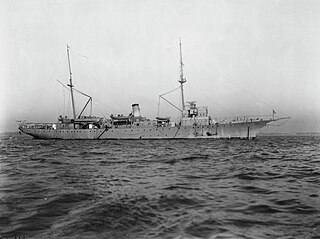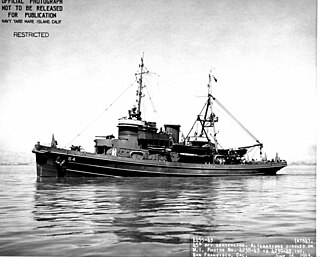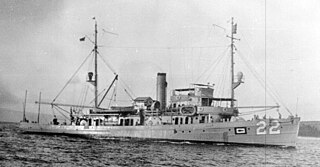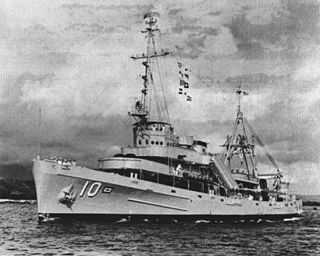
USS S-4 (SS-109) was an S-class submarine of the United States Navy. In 1927, she was sunk by being accidentally rammed by a United States Coast Guard destroyer with the loss of all hands but was raised and restored to service until stricken in 1936.

Mahan-class destroyers of the United States Navy were a series of 18 destroyers of which the first 16 were laid down in 1934. The last two of the 18, Dunlap and Fanning, are sometimes considered a separate ship class. All 18 were commissioned in 1936 and 1937. Mahan was the lead ship, named for Rear Admiral Alfred Thayer Mahan, an influential historian and theorist on sea power.

USS Wright (AZ-1/AV-1) was a one-of-a-kind auxiliary ship in the United States Navy, named for aviation pioneer Orville Wright. Originally built as a kite balloon tender, she was converted into a seaplane tender after kite balloons were no longer used.

USS Sumner (AG-32/AGS-5) was a survey ship in the United States Navy. She was named in honor of Thomas Sumner. She was originally commissioned as a submarine tender as USS Bushnell (AS-2/AG-32), in honor of David Bushnell, the inventor of the first American submarine.

USS Munsee (AT/ATF-107) was an Abnaki-class fleet ocean tug. She is the only ship of the United States Navy to hold the name Munsee, which is the name of a subtribe of the Delaware Indians, still living in Wisconsin and Kansas.

USS Downes (DD-375) was a Mahan-class destroyer in the United States Navy before and during World War II. She was the second ship named for John Downes, a US Navy officer.

A United States Navy diver refers to a service personnel that may be a restricted fleet line officer, civil engineer corps (CEC) officer, Medical Corps officer, or an enlisted who is qualified in underwater diving and salvage. Navy divers serve with fleet diving detachments and in research and development. Some of the mission areas of the Navy diver include: marine salvage, harbor clearance, underwater ship husbandry and repair, submarine rescue, saturation diving, experimental diving, underwater construction and welding, as well as serving as technical experts to the Navy SEALs, Marine Corps, and Navy EOD diving commands.

USS Walton (DE-361) was a John C. Butler-class destroyer escort in the United States Navy. It was named after Merrit Cecil Walton, a Marine Corps platoon sergeant with the U.S. 1st Marine Division, who died on Gavutu during the Battle of Guadalcanal and was posthumously awarded the Navy Cross for "extraordinary heroism".

USS Navajo (AT-64) was an oceangoing tugboat in the United States Navy, and the lead ship of its class. It was named for the Navajo people. Originally called the Navajo-class of fleet tugs, it was later renamed the Cherokee-class after loss of the first two ships of the class.

The third USS Falcon, (AM-28/ASR-2) was a Lapwing-class minesweeper in the United States Navy. She later became a submarine rescue ship.

The first USS Pigeon (AM-47/ASR-6) was a Lapwing-class minesweeper of the United States Navy. She was later converted to a submarine rescue ship. She was named for the avian ambassador, the pigeon.

USS Widgeon (AM-22/ASR-1) was an Lapwing-class minesweeper acquired by the United States Navy for the dangerous task of removing mines from minefields laid in the water to prevent ships from passing. Later converted to a submarine rescue ship. Widgeon was named by the Navy after the widgeon, a freshwater duck.
The first USS Chewink (AM-39/ASR-3) was a Lapwing-class minesweeper in the United States Navy. She was later converted to a submarine rescue ship.

USS Argonne (AP-4/AS-10/AG-31) was a Design 1024 cargo ship built under United States Shipping Board contract by the International Shipbuilding Corp., Hog Island, Pennsylvania, for the United States Department of War. Named Argonne for the U.S. Army's Meuse-Argonne campaign in World War I, she was completed in 1920, delivered to the War Department in December 1920, laid up in February 1921, and loaned to the Navy on 3 November 1921. Accepted preliminarily by the Navy on that date, she was commissioned as Argonne on 8 November 1921 at the Philadelphia Navy Yard. The ship was permanently transferred to the Navy 6 August 1924 by Executive Order.

USS Chanticleer (ASR-7) was the lead ship of her class of submarine rescue ships in the United States Navy. She served from 1942 to 1973 and was scrapped in 1974.

The USS Coucal (ASR-8) was a Chanticleer-class submarine rescue ship in the United States Navy.

USS Greenlet (ASR-10) was a Chanticleer-class submarine rescue ship in service with the United States Navy from 1943 to 1970. In June 1970, the ship was transferred to the Turkish Navy, renamed TCG Akin (A-585) and remained in service until 2017.
The second USS Bluebird (ASR-19) was a Penguin-class submarine rescue ship in the United States Navy.

USS Preserver (ARS-8) was a Diver-class rescue and salvage ship commissioned by the U.S. Navy for service in World War II. She was responsible for coming to the aid of stricken vessels.

USS Grasp (ARS-24) was a Diver-class rescue and salvage ship commissioned by the U.S. Navy during World War II. Her task was to come to the aid of stricken vessels.



















